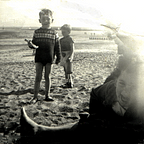Maria Walks Amid the Thorn
Ethereal beauty of neglected German advent hymn
The Visitation does not feature in many Nativity plays, taking place in the boring bit between the Angel Gabriel turning up and all the action in the manger. A pregnant Mary visits her older ‘relative’ Elizabeth, the mother to be of John the Baptist.
When Elizabeth heard Mary’s greeting, the child leaped in her womb. And Elizabeth was filled with the Holy Spirit and exclaimed with a loud cry, “Blessed are you among women, and blessed is the fruit of your womb. And why has this happened to me, that the mother of my Lord comes to me? For as soon as I heard the sound of your greeting, the child in my womb leaped for joy. And blessed is she who believed that there would be[a] a fulfillment of what was spoken to her by the Lord.” (Luke 1:42–45)
Elizabeth’s words form part of the Ave Maria (Hail Mary), one of the first prayers learned by Catholic children. They allude to a less familiar backstory — Elizabeth’s long period of infertility, also resolved by a divine intervention (‘what was spoken to her by the Lord’).
The precise interpretation of this episode has been haggled over by theologians. Maria Walks Amid the Thorn cuts to the metaphorical chase. Dead thorn wood symbolizing death and infertility dead miraculously blooms in the presence of Mary carrying the divine child.
Maria walks amid the thorns,
Kyrie eleison,
Maria walks amid the thorns,
Which seven years no leaf has born.
Jesus and Maria.
The second verse confirms but does not explain the miracle. It repeats the Greek prayer formula Kyrie eleison (“Lord, have mercy”)
What ‘neath her heart doth Mary bear?
Kyrie eleison,
The little Child doth Mary bear,
Beneath her heart He nestles there.
Jesus and Maria.
The origin of “Maria durch ein Dornwald ging” ( literally “Mary walked through a wood of thorn”) is a German Catholic Advent song that became popular in Germany and Austria in the late 19th Century.
Unlike other Silent Night, the hymn did not immediately export to the anglosphere, perhaps because of its overt Catholicism. Nor was its adoption by the German Youth Movement a selling point during the inter-war years
Eventually, Philip Radcliffe (1905–1986) provided a setting with English words for Kings College, Cambridge. It remains a neglected piece.
Free scores of “Maria durch ein Dornwald ging” are available from the Choral Public Domain Library (ChoralWiki). Arnos Vocale is a Bristol choir dedicated to beautiful song from the classical, jazz and folk traditions.
